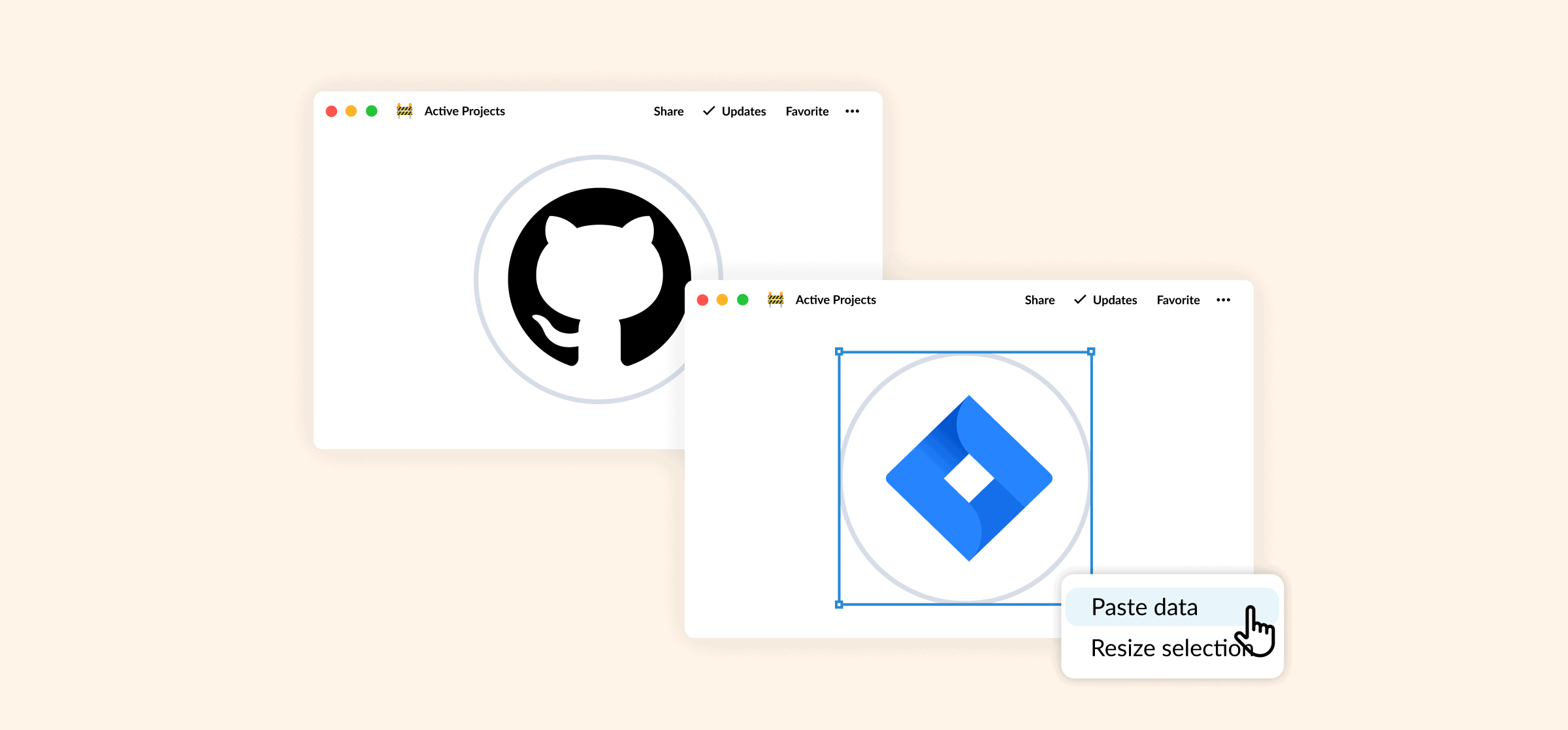Integrate GitHub Enterprise With Jira: Built-In vs. Unito
Many software developers work with both Jira and GitHub Enterprise, and keeping development tasks moving smoothly can be a major headache. Developers who work in GitHub Enterprise don’t want to jump into Jira, potentially missing context crucial to their work. Team leads and product managers who use Jira try to avoid sifting through pull requests to find the updates they need. That’s where an integration between Jira and GitHub Enterprise comes in.
That’s also why both Atlassian — the people behind Jira — and Unito offer an integration for GitHub Enterprise and Jira. Here’s a breakdown of both solutions.
Atlassian’s GitHub for Jira app
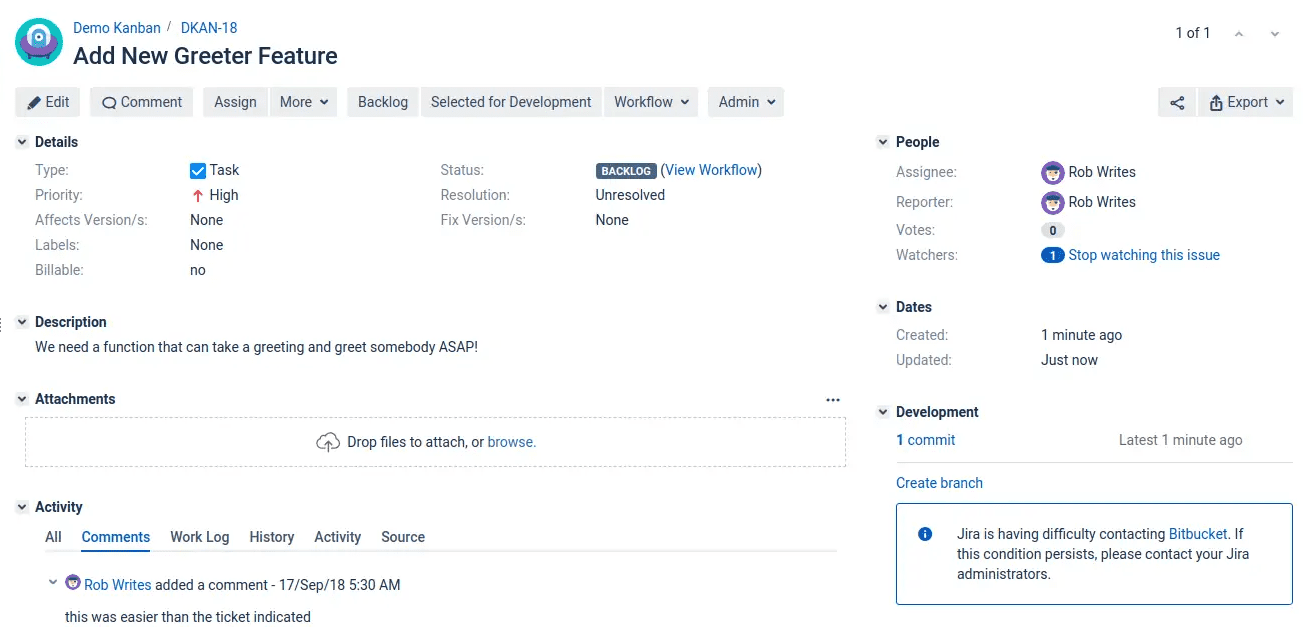
The GitHub for Jira app is a native integration, meaning it’s built right into Jira. In only a few minutes — and with the right admin permissions — you can start integrating GitHub repositories with Jira at no extra cost. But what does that actually look like in practice?
Notice the Development dropdown in the bottom-right corner of the Jira issue above? You’ll see it after connecting Jira with your GitHub Enterprise instance. With a single click, you can get more context for a Jira issue right from GitHub, like seeing new commits, pull requests, branches, and more. You can also click through to get more detail out of GitHub, just in case the snapshot in the issue isn’t enough.
Think of this integration as an easy way to get a window into the work happening in GitHub without leaving Jira.
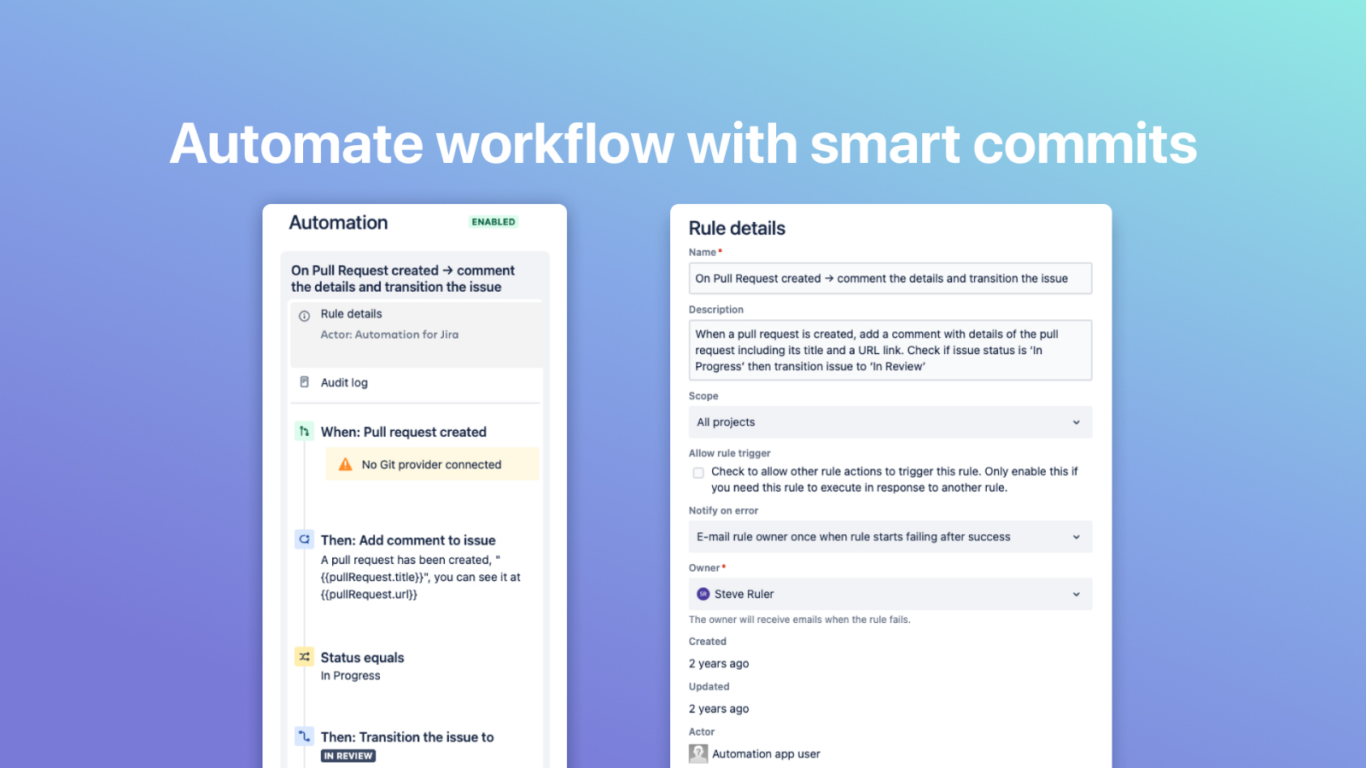
Smart commits are another key feature, allowing you to automate three actions in Jira based on what happens in GitHub:
- Comment on issues.
- Record time-tracking data.
- Move issues between statuses.
These basic automations can eliminate hours of manual work over time, quickly becoming valuable for any software team.
Why you should use Jira’s integration for GitHub Enterprise
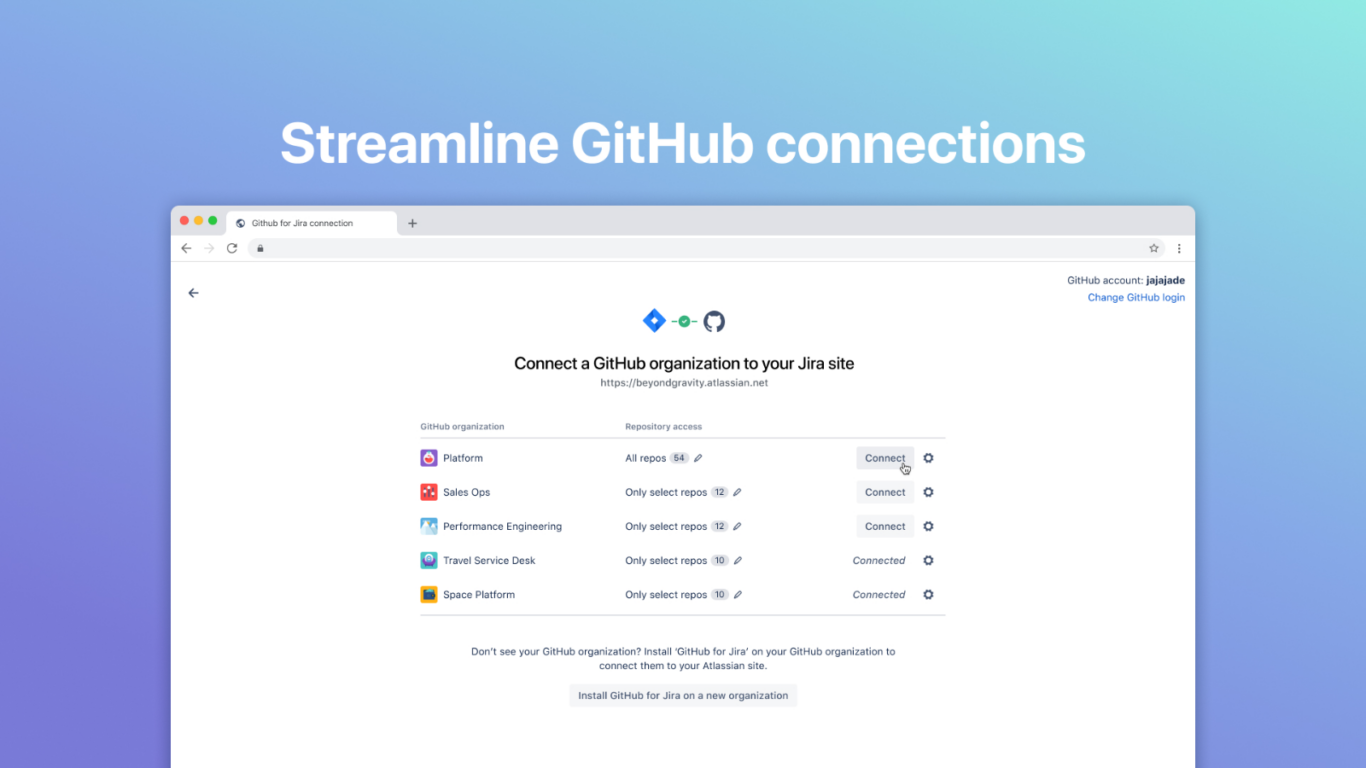
Simplicity
For some teams, this integration will strike the perfect balance between capability and simplicity. Want better visibility into GitHub? This integration offers it. You don’t need significant time or resource investment to get this integration to work. If all goes well, you can be up and running in less than a day.
Designed for all teams
Integrations built for tools like Jira and GitHub Enterprise are often extremely complicated to set up and deploy. It’s not uncommon to need to write code or click through a number of complicated menus. But with this integration, you won’t have to do that.
Home-court advantage
Who knows Jira’s platform better than the people at Atlassian? Because the integration is built by the same people who built the tool, you know it will work the way you need it to.
When you should use Atlassian’s GitHub for Jira app
This integration really shines when it empowers teams that want to be a bit more self-directed. Because Jira users can see what’s going on in Jira without leaving GitHub, they’re free to check in on progress their way, without needing to message someone for an update. Ultimately, this integration benefits workflows that need a window between the two tools, allowing for transparent information sharing.
Exporting Jira issues isn’t cutting it
Jira has built-in features you can use to export Jira issues to other tools using a CSV file, like Excel, Google Sheets, and even GitHub. But this is a completely manual process, and the file you get becomes outdated as soon as you export it.
Unito’s integration for Jira and GitHub Enterprise
When you connect your Jira projects with your GitHub Enterprise repos using a Unito workflow, you’re creating a two-way connection between issues in both tools. That means any changes made in one tool will be automatically updated in the other. Here’s every field Unito can sync between these tools:

With this integration, you don’t need complicated code or commands. Just go through your work as usual and Unito will take care of the rest. Unito supports GitHub Enterprise Server, GitHub Enterprise Cloud, Jira Server, and Jira Cloud. So no matter how your infrastructure is set up, Unito has an integration for you.
Why you should use this integration
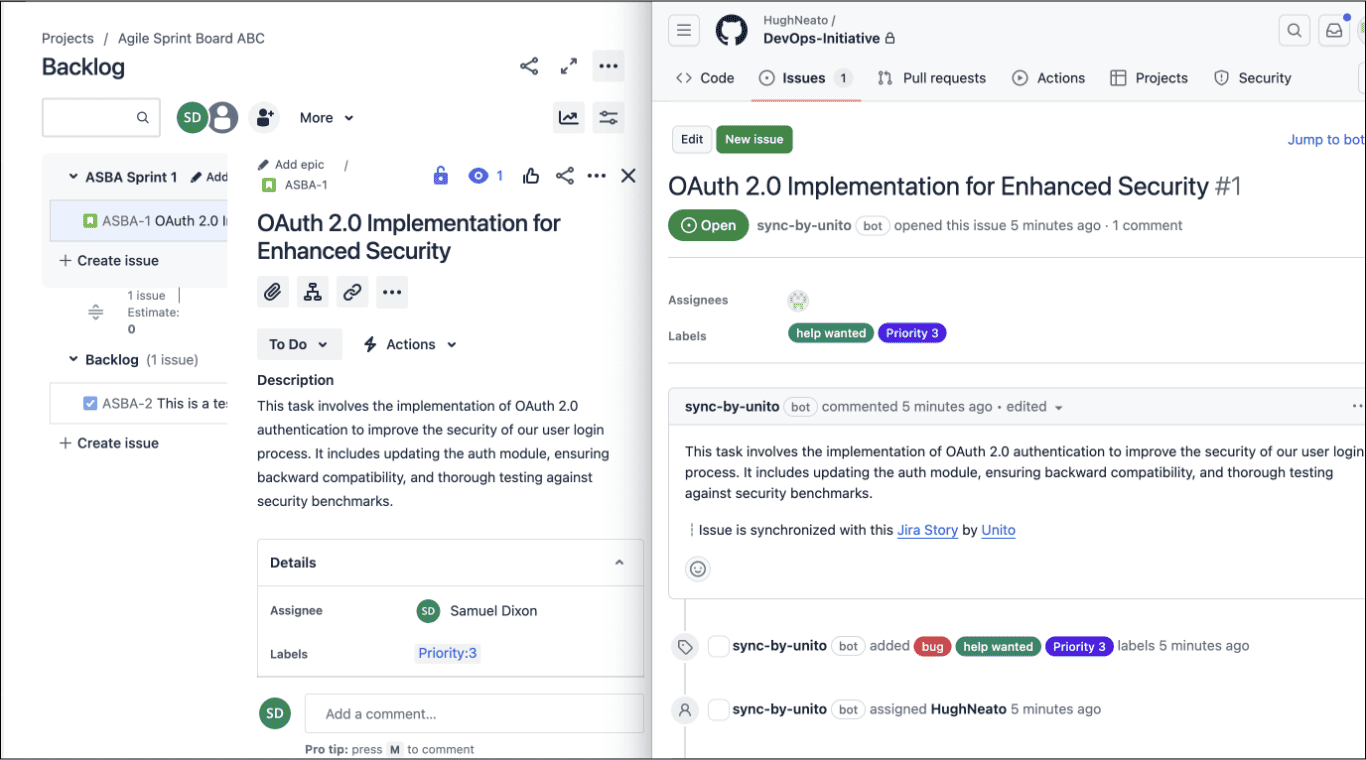
Transparent communication
Keeping teams aligned is challenging for any organization. Add a major tool difference and speed bumps can turn into walls. Without an integration, trying to get collaborators in Jira to communicate with GitHub users is impossible without going through another channel, like someone’s email inbox or meeting calendar. That, or someone has to go into someone else’s tool. With Unito’s integration, crucial information can pass from tool to tool, giving you the full picture without leaving your environment. You don’t just get more context, you get all the context the person in the other tool has.
Full interaction
With Jira’s GitHub Enterprise integration, your Jira issues get some additional context from GitHub and a few automations, but that’s it. That’s not the case with Unito.
When you sync Jira projects with GitHub Enterprise repos using Unito’s integration, you’re building relationships between each work item. That means changes made in one tool, to one issue, will directly affect the issue in the other tool. Change a due date in Jira and it’ll change in GitHub. Leave a comment and you’re communicating directly to people on both sides of the tool divide. Everyone can be an active contributor, no matter which tool they use.
Two-way collaboration
Jira’s integration is just about giving everyone more information. Unito’s integration is about turning the gap between Jira and GitHub into an opportunity for better collaboration.
Imagine if you could get information from both GitHub and Jira ahead of your sprint planning meetings with no extra work. Think about how much more powerful your roadmap would be if it wasn’t locked in Jira. You can capture priorities, updates, and more from both tools and give everyone access to them.
With Unito’s two-way workflows, every action and bit of information is transferred from Jira to GitHub and back again. Teams can work together without leaving their tool. Would you work remotely without Zoom or Google Meet? That’s the kind of need Unito is solving.
When you should use this integration
Because Unito’s Jira GitHub integration creates such a deep relationship between your Jira projects and your GitHub repos, it shines when it powers cross-functional collaboration. Think of a project that could benefit from the contributions of multiple teams, even those scattered throughout Jira and GitHub. How much better could that project be if you could bring those teams together and you didn’t need a meeting to do it?
But Unito doesn’t only work for internal processes. You can also use it for agency and client work, or ITSM with ServiceNow. This gives you the same kind of transparency you’d be used to internally, while maintaining informational security. Here’s how The Taproom, which builds custom development solutions for businesses on Shopify, uses Unito to do just that.
Which integration is right for you?
If you want better visibility into GitHub from Jira with a bit more interaction, then Atlassian’s integration is probably your best bet. But if you’re looking for a deeper integration, one that enables project-level visibility and two-way cross-team collaboration across Jira and GitHub, Unito is the best fit.
FAQ: Integrating a GitHub enterprise repository with Jira
How do I integrate a GitHub repository with Jira?
You can integrate GitHub repositories with Jira in one of four ways:
- Using fully customizable, quickly deployed 2-way integrations from Unito.
- Setting up GitHub for Jira, Atlassian’s built-in integration tool.
- Deploying costly, technical integration tools like Workato or Tray.ai.
- Buying simple one-way automation tools like Zapier.
Is Jira compatible with GitHub?
Jira isn’t compatible with GitHub by default; you’ll need extra tools to connect the two. While Atlassian offers a built-in solution for doing this, third-party tools like Unito usually provide deeper integrations.
How do you link a GitHub branch to Jira?
You can use Atlassian’s built-in GitHub for Jira tool or third-party integration solutions like Unito.
What are the benefits of using a Jira integration with GitHub?
Using a Jira integration with GitHub comes with several benefits:
- Increased visibility across software development teams.
- Better reporting for leaders and project managers.
- The advantages of both tools without the disadvantages (like copying and pasting data).
- Using the best tool for the job in all situations without losing important context.

